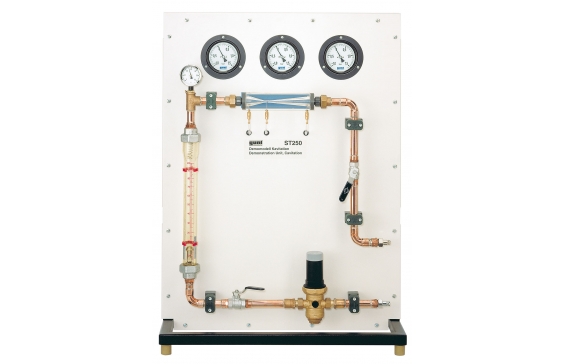ST 250 Cavitation

Cavitation refers to the formation of vapour bubbles in flowing fluids due to strong low pressure. As the flow velocity increases, the static pressure of the fluid falls to the vapour pressure and leads to the formation of vapour bubbles. The bubbles are carried along by the flow and implode if, with decreasing velocity, the static pressure rises above the vapour pressure of the fluid.
ST 250 is suitable for the demonstration of cavitation processes using the example of a Venturi nozzle. Pressure energy is converted into kinetic energy and vice versa in the Venturi nozzle. Vapour bubbles form in the narrowest cross-section.
To visualise the flow processes the experimental unit includes a Venturi nozzle made of transparent plastic. There are three pressure measuring points on the Venturi nozzle: at the inlet, at the narrowest point and at the outlet. The input pressure can be adjusted via a pressure reducing valve. The flow rate and the pressures can be adjusted via two ball valves which are located at the inlet and outlet of the pipe system.
The pressure distribution within the Venturi nozzle is shown on three manometers. The flow can be read off a rotameter. The temperature is measured directly upstream of the Venturi nozzle and is displayed on the thermometer.
- investigation of cavitation processes
- visualisation of the formation of vapour bubbles in a Venturi nozzle
Pressure reducing valve
- 0,5…2bar
- up to 70°C
Transparent Venturi nozzle
- cross-section of flow
- inner diameter: 18mm
- contraction: 10,5°
- output cross-section
- inner diameter: 18mm
- enlargement: 4°
- narrowest cross-section
- inner diameter: 3,5mm
Measuring ranges
- pressure: -1…1,5bar
- temperature: 0…60°C
- flow rate: 0…1000L/h
- investigation of cavitation processes in a Venturi nozzle
- Venturi nozzle with 3 pressure measuring points
- adjustment of the flow rate via ball valves
- pressure reducing valve, adjustable
- thermometer for measuring the temperature
- flow measurement using rotameter
- manometer for displaying the pressure curve in the Venturi nozzle
- function of a Venturi nozzle
- pressure as a function of the flow rate
- cavitation processes at different flow rates and pressures
